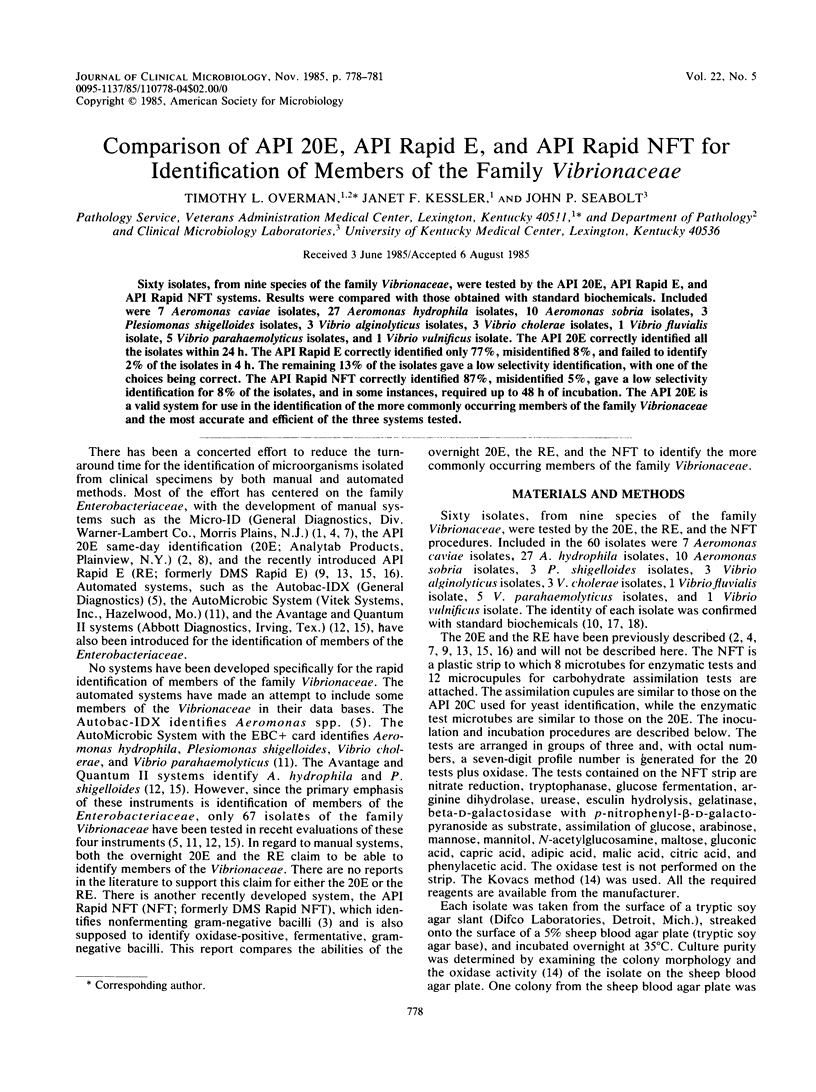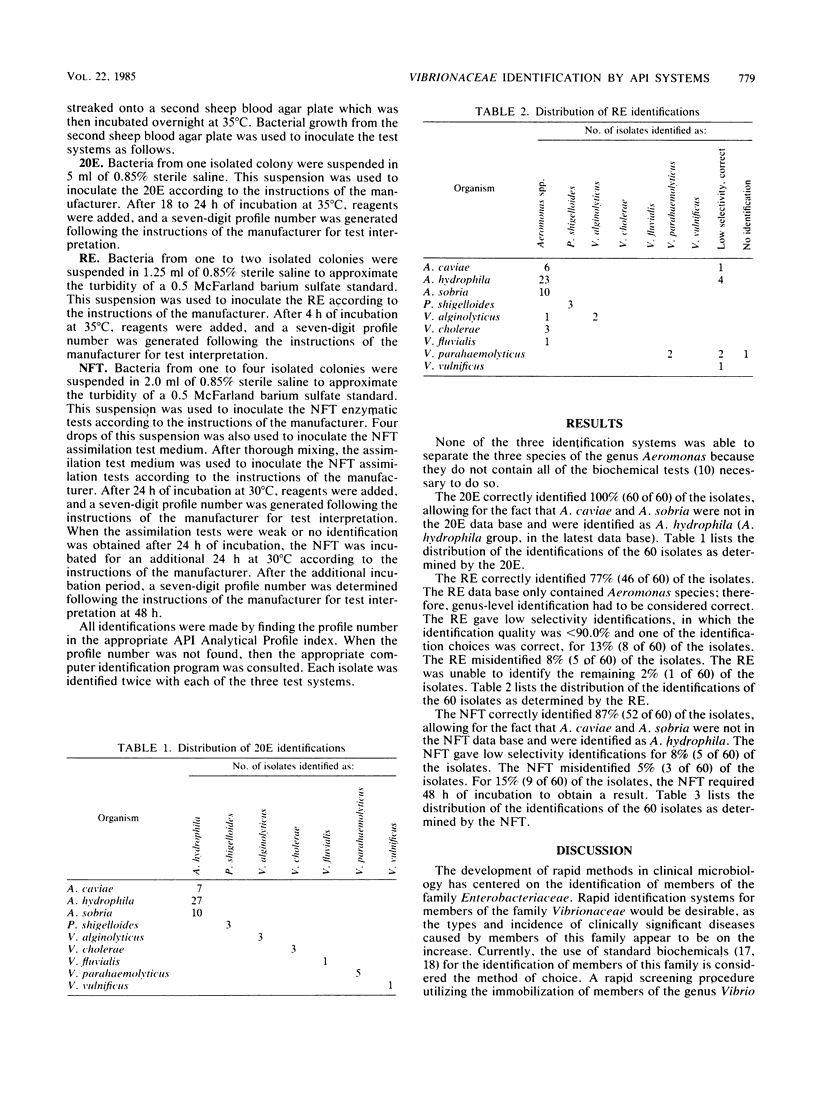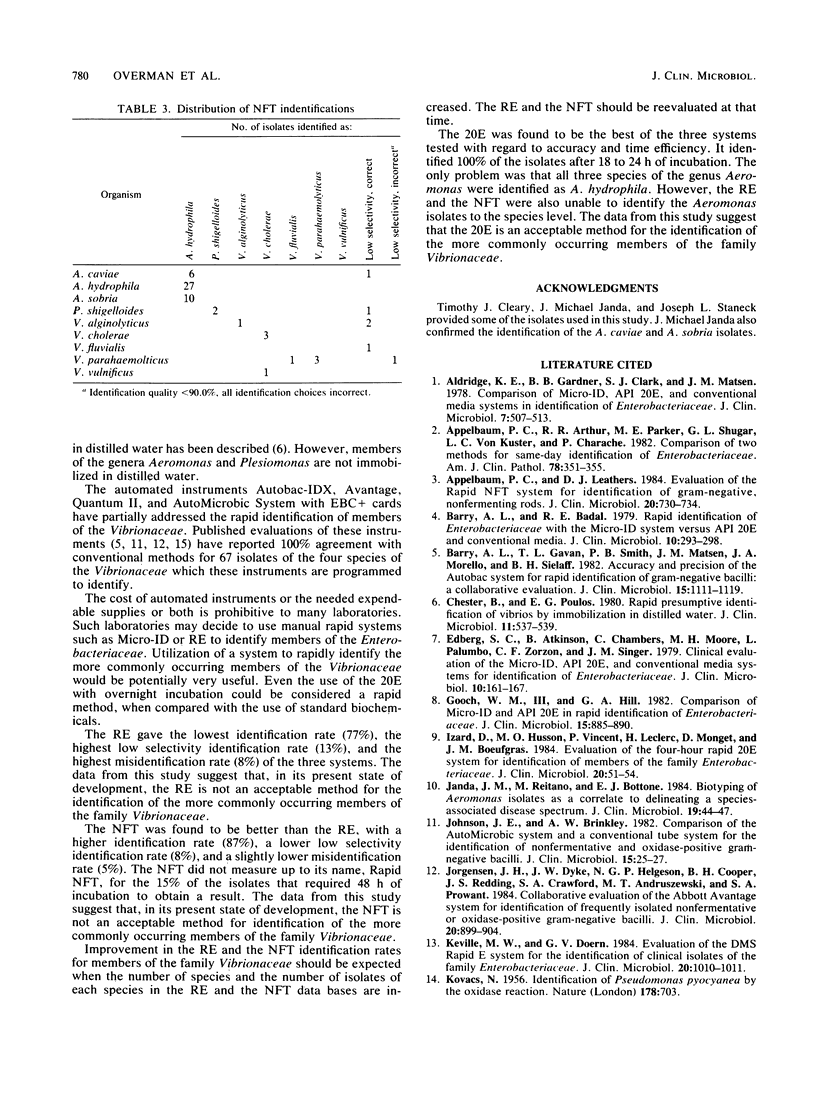Abstract
Sixty isolates, from nine species of the family Vibrionaceae, were tested by the API 20E, API Rapid E, and API Rapid NFT systems. Results were compared with those obtained with standard biochemicals. Included were 7 Aeromonas caviae isolates, 27 Aeromonas hydrophilia isolates, 10 Aeromonas sobria isolates, 3 Plesiomonas shigelloides isolates, 3 Vibrio alginolyticus isolates, 3 Vibrio cholerae isolates, 1 Vibrio fluvialis isolate, 5 Vibrio parahaemolyticus isolates, and 1 Vibrio vulnificus isolate. The API 20E correctly identified all the isolates within 24 h. The API Rapid E correctly identified only 77%, misidentified 8%, and failed to identify 2% of the isolates in 4 h. The remaining 13% of the isolates gave a low selectivity identification, with one of the choices being correct. The API Rapid NFT correctly identified 87%, misidentified 5%, gave a low selectivity identification for 8% of the isolates, and in some instances, required up to 48 h of incubation. The API 20E is a valid system for use in the identification of the more commonly occurring members of the family Vibrionaceae and the most accurate and efficient of the three systems tested.
Full text
PDF



Selected References
These references are in PubMed. This may not be the complete list of references from this article.
- Aldridge K. E., Gardner B. B., Clark S. J., Matsen J. M. Comparison of micro-ID, API 20E, and conventional media systems in identification of Enterobacteriaceae. J Clin Microbiol. 1978 Jun;7(6):507–513. doi: 10.1128/jcm.7.6.507-513.1978. [DOI] [PMC free article] [PubMed] [Google Scholar]
- Appelbaum P. C., Arthur R. R., Parker M. E., Shugar G. L., Von Kuster L. C., Charache P. Comparison of two methods for same-day identification of Enterobacteriaceae. Am J Clin Pathol. 1982 Sep;78(3):351–355. doi: 10.1093/ajcp/78.3.351. [DOI] [PubMed] [Google Scholar]
- Appelbaum P. C., Leathers D. J. Evaluation of the rapid NFT system for identification of gram-negative, nonfermenting rods. J Clin Microbiol. 1984 Oct;20(4):730–734. doi: 10.1128/jcm.20.4.730-734.1984. [DOI] [PMC free article] [PubMed] [Google Scholar]
- Barry A. L., Badal R. E. Rapid identification of Enterobacteriaceae with the micro-ID system versus API 20E and conventional media. J Clin Microbiol. 1979 Sep;10(3):293–298. doi: 10.1128/jcm.10.3.293-298.1979. [DOI] [PMC free article] [PubMed] [Google Scholar]
- Barry A. L., Gavan T. L., Smith P. B., Matsen J. M., Morello J. A., Sielaff B. H. Accuracy and precision of the autobac system for rapid identification of Gram-negative bacilli: a collaborative evaluation. J Clin Microbiol. 1982 Jun;15(6):1111–1119. doi: 10.1128/jcm.15.6.1111-1119.1982. [DOI] [PMC free article] [PubMed] [Google Scholar]
- Chester B., Poulos E. G. Rapid presumptive identification of vibrios by immobilization in distilled water. J Clin Microbiol. 1980 May;11(5):537–539. doi: 10.1128/jcm.11.5.537-539.1980. [DOI] [PMC free article] [PubMed] [Google Scholar]
- Edberg S. C., Atkinson B., Chambers C., Moore M. H., Palumbo L., Zorzon C. F., Singer J. M. Clinical evaluation of the MICRO-ID, API 20E, and conventional media systems for identification of Enterobacteriacea. J Clin Microbiol. 1979 Aug;10(2):161–167. doi: 10.1128/jcm.10.2.161-167.1979. [DOI] [PMC free article] [PubMed] [Google Scholar]
- Gooch W. M., 3rd, Hill G. A. Comparison of micro-ID and API 20E in rapid identification of Enterobacteriaceae. J Clin Microbiol. 1982 May;15(5):885–890. doi: 10.1128/jcm.15.5.885-890.1982. [DOI] [PMC free article] [PubMed] [Google Scholar]
- Izard D., Husson M. O., Vincent P., Leclerc H., Monget D., Boeufgras J. M. Evaluation of the four-hour rapid 20E system for identification of members of the family Enterobacteriaceae. J Clin Microbiol. 1984 Jul;20(1):51–54. doi: 10.1128/jcm.20.1.51-54.1984. [DOI] [PMC free article] [PubMed] [Google Scholar]
- Janda J. M., Reitano M., Bottone E. J. Biotyping of Aeromonas isolates as a correlate to delineating a species-associated disease spectrum. J Clin Microbiol. 1984 Jan;19(1):44–47. doi: 10.1128/jcm.19.1.44-47.1984. [DOI] [PMC free article] [PubMed] [Google Scholar]
- Johnson J. E., Brinkley A. W. Comparison of the AutoMicrobic system and a conventional tube system for identification of nonfermentative and oxidase-positive gram-negative bacilli. J Clin Microbiol. 1982 Jan;15(1):25–27. doi: 10.1128/jcm.15.1.25-27.1982. [DOI] [PMC free article] [PubMed] [Google Scholar]
- Jorgensen J. H., Dyke J. W., Helgeson N. G., Cooper B. H., Redding J. S., Crawford S. A., Andruszewski M. T., Prowant S. A. Collaborative evaluation of the Abbott Avantage system for identification of frequently isolated nonfermentative or oxidase-positive gram-negative bacilli. J Clin Microbiol. 1984 Nov;20(5):899–904. doi: 10.1128/jcm.20.5.899-904.1984. [DOI] [PMC free article] [PubMed] [Google Scholar]
- KOVACS N. Identification of Pseudomonas pyocyanea by the oxidase reaction. Nature. 1956 Sep 29;178(4535):703–703. doi: 10.1038/178703a0. [DOI] [PubMed] [Google Scholar]
- Keville M. W., Doern G. V. Evaluation of the DMS Rapid E system for identification of clinical isolates of the family Enterobacteriaceae. J Clin Microbiol. 1984 Nov;20(5):1010–1011. doi: 10.1128/jcm.20.5.1010-1011.1984. [DOI] [PMC free article] [PubMed] [Google Scholar]
- Murray P. R., Gauthier A., Niles A. Evaluation of the Quantum II and Rapid E identification systems. J Clin Microbiol. 1984 Sep;20(3):509–514. doi: 10.1128/jcm.20.3.509-514.1984. [DOI] [PMC free article] [PubMed] [Google Scholar]
- Overman T. L., Plumley D., Overman S. B., Goodman N. L. Comparison of the API rapid E four-hour system with the API 20E overnight system for the identification of routine clinical isolates of the family Enterobacteriaceae. J Clin Microbiol. 1985 Apr;21(4):542–545. doi: 10.1128/jcm.21.4.542-545.1985. [DOI] [PMC free article] [PubMed] [Google Scholar]


